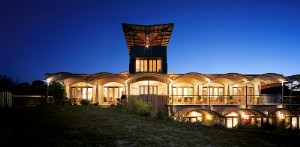On the Wild Side at Moorooduc Estate (Mornington Peninsula, Victoria, Australia)
Continuing with our December 2005 visit to
Mornington Peninsula and its wineries.
All the hospitality we received at
Stonier Wines left us with only a small amount of time to make our 1pm lunch reservation at
Jill's at
Moorooduc Estate. I’d set up the lunch reservation and some wine tasting with Kate McIntyre, daughter of Moorooduc Estate owners Richard and Jill McIntyre. In one of her emails Kate had written “Give us a call if you have any problems finding us!”
That was, of course, well before we had even boarded the plane to Oz, let alone actually being in the process of motoring down Frankston Road after leaving Stonier. “OK, so we just turn left onto Balnarring Road and then right onto Derril Road.” That sounds simple. And as long as you don’t drive past Derril Road, it is! Once you go past Foxys Road you will be able to figure it – Derril Road is behind you. Have I mentioned the narrow roads yet? Or the undulations that hide oncoming cars? Thought not. How about Derils Road being dirt. No? Oh well, never mind. The drive past Devilbend Reservoir has a calming influence. More importantly Moorooduc Estate is worth the effort.
We actually arrived slightly early and so dropped into the tasting room to see if we could find Kate before heading to Jill’s restaurant for lunch. “Is Kate McIntyre about?” “Oh you must be her American visitors. I think she’s in the main building.” She was indeed, and she wasn’t alone. Samwise and Pedro were with her, and while they turned out to be a little more cautious in their greeting than Kate we were very happy to meet them. Miranda was particularly happy; she hadn’t seen a Poodle for at least two days.

The main building at Moorooduc Estate is very impressive, certainly the most beautiful of the wineries we visited on the Peninsula. Its rammed earth construction is both rustic and modern, and most certainly spacious. Jill’s, their restaurant, overlooks vineyards and the Moorooduc Valley. My first impression of Moorooduc wines was the
2001 The Moorooduc Pinot Noir (French oak) that I had with lunch. Cherry red in color with an orange tinged edge, my glass gave waves and waves of spicy Pinot Noir notes over stewed quince and an appealing earthy, meaty bouquet. Medium to full bodied it was beautifully soft and supple with a backbone of juicy acidity and very fine tannins supporting a lengthy finish. 2, 2, 4.5, 10.3 = 18.8/20, 94/100. It was a brilliant accompaniment to the excellent food served at Jill’s. Moorrooduc also offers accommodation for those who might want to spend some quality time among the vines and away from everything else.
Similar to many Mornington Peninsula wineries Moorooduc Estate is a relative newcomer. It was founded in 1982. The vineyards total about 12 acres and are in a warmer and more elevated area than Stonier. Production is relatively small, about 2,500 to 3,000 cases per year. What is unique to Moorooduc is that the wines are fermented using yeasts present in the vineyards. Wild yeast fermentation was begun in 1996 at Moorooduc and within five years (2001 vintage) all the Estate wines were being produced using wild yeast fermentation. The yeast strains have not been identified and so it is not known if the same strains are active in the annual fermentations, or indeed if the yeasts are truly wild; they may have originated from commercial yeast used in the earliest vintages. In any case wild fermentation is a clear sign that Richard McIntyre has considerable confidence in his abilities as a winemaker.
Moorooduc Estate makes three levels of wine, all of which will be under screwcap with the 2004 vintage. The Devil Bend wines are made with fruit sourced from viticulturally different parts of Mornington Peninsula. The Estate wines reflect the Moorooduc subregion and include fruit from the Estate’s Derril Road vineyard. The top of the line are the wines labeled The Moorooduc. Sourced from the best of the Derril Road fruit, these wines are made in very limited quantities.
My notes are in the order the wines were tasted. First up was the
2004 Pinot Gris (Screwcap) (French oak). Light straw yellow in color it gave a fresh, yeasty aroma backed up by lemon and anise. Those flavors as well as some herbaceousness carry onto the palate. The feel of the wine in the mouth is soft and round (malolactic?). It’s a fruit driven wine that gives the impression of slight sweetness. There is nice length to the finish. 2, 2, 3.6, 9.8 = 17.4/20, 87/100. 14% alcohol. Next was the
2002 Devils Bend Creek Chardonnay (French oak). Light straw yellow in color, I detected a slight reductive character. Pleasant fruit without great complexity. Appealingly soft in the mouth (from malolactic fermentation), there is just a touch of oak evident. 2, 2, 3.6, 9.8 = 17.4/20, 87/100. 13.5% alcohol. The
2003 Moorooduc Estate Chardonnay (French oak – 35% new) (100% barrel ferment) was light straw in color with opulent aromatics. Its a mouth pleasing wine with no sharp edges, impressive balance and a lengthy finish. 2, 2, 4.1, 10.2 = 18.3/20, 92/100. 13.5% alcohol. Surprisingly I found the
2003 The Moorooduc Chardonnay (French Oak – 40% new) only (very) slightly better than its little sister at this stage of its life. Others will certainly disagree with my assessment. But I found this light straw yellow wine just a little too influenced by oak characters at present. But its quality is clearly evident once the wine hits your mouth. Wonderfully soft and graceful on the palate, beautifully balanced and with great length to the finish, it is a wine that will take 3 to 5 years to show its real class. 2, 2, 4.0, 10.4 = 18.4/20, 92/100.
The first of the red wines tasted was the
2003 Devils Bend Creek Pinot Noir (French oak – 10% or less new oak). Light cherry with pink edge. Very nice spicy Pinot Noir character with notes of stewed quince, strawberry, and just a little nail polish. Medium to full bodied with juicy acidity and excellent presence of flavors on the palate. 2, 2, 3.9, 9.8 = 17.7/20, 88/100. 14% alcohol. The
2003 Moorooduc Estate Pinot Noir (French Oak) is light cherry with pink edge. At this stage more restrained than the Devils Bend Pinot with notes of pepper and sawdust. This wine really comes alive in the mouth with a burst of spiciness. Excellent mouthfeel, nice balance, and great length to the finish mark a very attractive wine. 2, 2, 4.0, 10.0= 18.0, 90/100. 14% alcohol. The top of the line
2003 The Moorooduc Pinot Noir (Screwcap) (French Oak) is light cherry with pink edge in color. Beautiful complex savoury earth notes backed up by slight pepper over spicy Pinot. Simply excellent. Medium to full bodied it is soft and supple in the mouth with excellent presence of flavors on the palate, and juicy acidity to the end of the lengthy finish. 2, 2, 4.4, 10.2 = 18.6/20, 93/100. 14% alcohol.
The
2004 Moorooduc Shiraz (Screwcap) (French Oak) (Not released at time of tasting) was cherry red with pink edge. Pleasantly complex with black pepper turning to a slight herbaceousness. There are also bright dark fruits notes that evolve into attractive jammy characters. Nice mouthfeel with excellent carry of flavors onto the palate. Impressive balance with the juicy acidity marrying well with firm but not overdone astringency. 2, 2, 4.1, 10.1 = 18.2/20, 91/100. 14% alcohol. Next was the
2000 Moorooduc Cabernet Sauvignon (French Oak) (80% Cabernet Sauvignon, rest Merlot and Cabernet Franc). Light cherry red with a faint orange tinge to the edge to indicate some age. The aromas come in waves of spearmint and menthol over cedar. In the mouth its medium bodied but soft, almost Pinot Noir-like, as it caresses the palate. Nice carry of flavors onto the palate. Not great cabernet, but an interesting attempt. 2, 2, 3.8, 9.8 = 17.6/20, 88/100. 13% alcohol. Last was the
2001 Moorooduc Shiraz (French Oak). Cherry red with very faint orange tinge to the edge. Very attractive cool climate pepper and savory notes with just a touch of nail polish. To most Barossa Shiraz drinkers this wine will probably seem thin but for me there was a softness and elegance that was both appealing and distinctive. 2, 2, 4.1, 10.2 = 18.3/20, 92/100. 13.5% alcohol.
It is unlikely that much Moorooduc wine ever finds its way to the USA, the production is simply too small. So as we were leaving I purchased a mixed 6-pack to savor during the rest of our visit downunder. After our goodbyes to Kate, Samwise and Pedro, we headed off in the direction of
Port Phillip Estate. I’ve already said that you need a really good map to find wineries in Mornington Peninsula, haven’t I?
Disclaimer: In the interests of full disclosure I have to note that our meal at Jill’s was provided gratis by Kate McIntyre.





